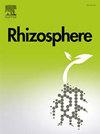丛枝菌根真菌介导了葱根际和内生细菌群落中罕见的分类群和网络复杂性
IF 3.5
3区 生物学
Q1 PLANT SCIENCES
引用次数: 0
摘要
丛枝菌根真菌(AMF)在促进植物生长和调节根际微生物组成方面起着重要作用。然而,它们对葱根际和内生环境中罕见细菌类群的影响尚不清楚。为了解决这一空白,我们进行了随机试验,分为4个处理组:3个处理组接种30 g不规则根噬菌(Rhizophagus irregularis)、异孢菌(Diversispora epigaea)或mosfuneliformis mosseae, 1个未接种对照组接种无菌接种物(每个20个重复),利用实时定量PCR和Illumina MiSeq测序分析微生物群落。结果表明,amf接种后植株的表型性状显著优于对照,其株高分别为(26.05±2.88 cm)、(28.63±2.09 cm)和(24.92±2.86 cm),高于对照(8.59±1.60 cm)。在AMF处理中,不规则R. irregularis菌株显著促进生长,其感染率高,但感染强度低于D. epigaea和F. mosseae菌株。根际群落中罕见细菌类群的特异扩增序列变异增多,而内生群落中关键类群的丰度增加。此外,接种AMF会导致与碳、氮和磷循环相关的功能基因表达的改变。其中,cbbLR和phoD基因的表达显著升高,而amoA基因的表达保持稳定。此外,根际细菌网络的复杂性明显高于内生环境。这些发现强调了AMF在塑造微生物群落和促进植物健康方面的不同作用。本文章由计算机程序翻译,如有差异,请以英文原文为准。
Arbuscular mycorrhizal fungi mediate rare taxa and network complexity in rhizospheric and endophytic bacterial communities of Allium schoenoprasum L
Arbuscular mycorrhizal fungi (AMF) play a crucial role in enhancing plant growth and regulating rhizospheric microbial composition. However, their influence on rare bacterial taxa in both the rhizospheric and endophytic environments of Allium schoenoprasum L. remains largely unknown. To address this gap, we conducted a randomized experiment with four treatment groups: three inoculated with 30 g of Rhizophagus irregularis, Diversispora epigaea, or Funneliformis mosseae, and one uninoculated control group with sterilized inoculum (20 replicates each), using real-time quantitative PCR and Illumina MiSeq sequencing to analyze microbial communities. Results showed that AMF-inoculated plants exhibited significantly superior phenotypic traits compared to the control, with plant heights of 26.05 ± 2.88 cm (R. irregularis), 28.63 ± 2.09 cm (D. epigaea), and 24.92 ± 2.86 cm (F. mosseae) versus 8.59 ± 1.60 cm in the control, alongside significant differences in other traits. Among AMF treatments, R. irregularis strain notably promoted growth effectively with a high infection rate but lower infection intensity than D. epigaea and F. mosseae strains. Rhizospheric communities had more unique amplified sequence variants among rare bacterial taxa, while endophytic communities showed increased abundances of key taxa. Furthermore, inoculation with AMF leads to alterations in the expression of functional genes associated with the carbon, nitrogen, and phosphorus cycles. Specifically, the expression of the cbbLR and phoD genes was significantly elevated, while the expression of the amoA gene remained stable. Additionally, the complexity of the rhizospheric bacterial network was notably greater compared to the endophytic environment. These findings highlight the different roles of AMF in shaping microbial communities and promoting plant health.
求助全文
通过发布文献求助,成功后即可免费获取论文全文。
去求助
来源期刊

Rhizosphere
Agricultural and Biological Sciences-Agronomy and Crop Science
CiteScore
5.70
自引率
8.10%
发文量
155
审稿时长
29 days
期刊介绍:
Rhizosphere aims to advance the frontier of our understanding of plant-soil interactions. Rhizosphere is a multidisciplinary journal that publishes research on the interactions between plant roots, soil organisms, nutrients, and water. Except carbon fixation by photosynthesis, plants obtain all other elements primarily from soil through roots.
We are beginning to understand how communications at the rhizosphere, with soil organisms and other plant species, affect root exudates and nutrient uptake. This rapidly evolving subject utilizes molecular biology and genomic tools, food web or community structure manipulations, high performance liquid chromatography, isotopic analysis, diverse spectroscopic analytics, tomography and other microscopy, complex statistical and modeling tools.
 求助内容:
求助内容: 应助结果提醒方式:
应助结果提醒方式:


